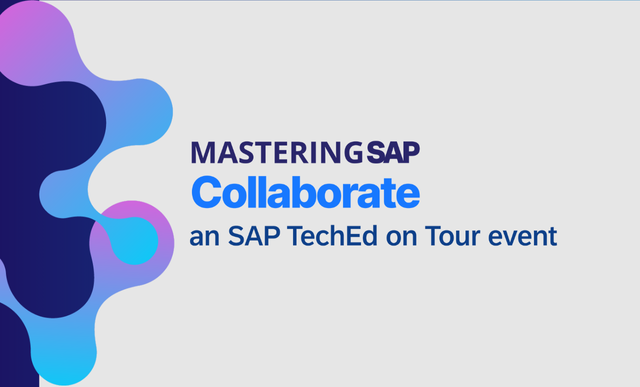SAP Supply Chain Management
SAP APO | SAP Asset Management | SAP Business Network | SAP Digital Manufacturing Cloud | SAP Digital Twin | SAP EWM | SAP IBP | SAP Inventory Management | SAP Label Printing | SAP Logistics | SAP Manufacturing | SAP Manufacturing Automation | SAP MES | SAP MII | SAP MM | SAP MRO | SAP MRP | SAP Order Management | SAP Plant Maintenance | SAP PLM | SAP Production Planning | SAP S&OP | SAP SD | SAP SPM | SAP Supply Chain Planning | SAP Track and Trace | SAP Transportation Management
Filter By
Browse By
- SAP Analytics and AI
- SAP Application Development and Integration
- All SAP Application Development and Integration
- SAP ABAP
- SAP ABAP Development Tools
- SAP ABAP Test Cockpit
- SAP API Management
- SAP BAPI
- SAP Basis
- SAP BRF
- SAP Business Application Studio
- SAP CMS
- SAP Design Studio
- SAP Development Tools
- SAP DevOps
- SAP EAI
- SAP EDI
- SAP Extension Suite
- SAP Fiori
- SAP Fiori Elements
- SAP Integration Suite
- SAP Low Code Application Development
- SAP Low Code Automation
- SAP Netweaver
- SAP Release Management
- SAP UI5
- SAP Web Application Server
- SAP Web IDE
- SAP Business Process Management
- SAP Center of Excellence
- SAP CIO
- SAP Customer Experience
- SAP Data and Data Management
- All SAP Data and Data Management
- SAP BW
- SAP BW/4HANA
- SAP Crystal Reports
- SAP Data Archiving
- SAP Data Center
- SAP Data Governance
- SAP Data Integration
- SAP Data Migration
- SAP Data Quality
- SAP Data Services
- SAP Data Strategy
- SAP Data Visualization
- SAP Data Warehouse Cloud
- SAP DMS
- SAP Document Control
- SAP EIM
- SAP ETL
- SAP ETL Tools
- SAP HANA
- SAP HANA Administration
- SAP HANA Deployment Infrastructure
- SAP HANA Studio
- SAP Master Data
- SAP Master Data Governance
- SAP MDM
- SAP Enterprise Architect
- SAP Enterprise Asset Management
- SAP ERP
- SAP Finance
- All SAP Finance
- SAP Accounting
- SAP AR AP
- SAP Asset Accounting
- SAP Billing Systems
- SAP BPC
- SAP BRIM
- SAP Cash Management
- SAP Central Finance
- SAP Controlling
- SAP COPA
- SAP Cost Center Accounting
- SAP Currency Risk
- SAP e-invoicing
- SAP FICO
- SAP Finance Automation
- SAP Advanced Financial Closing
- SAP Financial Consolidation
- SAP Financial Planning
- SAP FX Risk
- SAP General Ledger
- SAP Global Tax Management
- SAP Hyperion
- SAP Order to Cash
- SAP Payment Processing
- SAP Profitability Analysis
- SAP Rebate Management
- SAP S/4HANA Finance
- SAP SWIFT Compliance
- SAP Treasury Management
- SAP Universal Journal
- SAP Governance Risk and Compliance
- SAP Human Capital Management
- SAP Intelligent Technologies
- SAP Platform and Technology
- All SAP Platform and Technology
- SAP Business Technology Platform
- SAP Cloud
- SAP Cloud Connector
- SAP Cloud Integration Platform
- SAP Cloud Migration
- SAP Cloud Platform
- SAP Cloud Providers
- SAP Cloud Strategy
- SAP Digital Signature
- SAP Container Platform
- SAP HANA Enterprise Cloud
- SAP Digital Asset Management
- SAP Smart Forms
- SAP HEC
- SAP Digital Integration Hub
- SAP Hyperscalers
- SAP Infrastructure
- SAP Messaging
- SAP Quality and Testing
- SAP Security
- SAP Spend Management
- SAP Supply Chain Management
- All SAP Supply Chain Management
- SAP APO
- SAP Asset Management
- SAP Business Network
- SAP Digital Manufacturing Cloud
- SAP Digital Twin
- SAP EWM
- SAP IBP
- SAP Inventory Management
- SAP Label Printing
- SAP Logistics
- SAP Manufacturing
- SAP Manufacturing Automation
- SAP MES
- SAP MII
- SAP MM
- SAP MRO
- SAP MRP
- SAP Order Management
- SAP Plant Maintenance
- SAP PLM
- SAP Production Planning
- SAP S&OP
- SAP SD
- SAP SPM
- SAP Supply Chain Planning
- SAP Track and Trace
- SAP Transportation Management
- SAP System Administration
SAP Supply Chain: Supply Chain Management
A well-managed supply chain can significantly reduce a company’s operating expenses and increase profits. A supply chain requires active management because it is affected by many factors outside the control of the business. Current events causing global supply chain disruptions include the Russia-Ukraine War and the continuing effects of COVID-19.
SAP Supply Chain: Supply Chain Management
A well-managed supply chain can significantly reduce a company’s operating expenses and increase profits. A supply chain requires active management because it is affected by many factors outside the control of the business. Current events causing global supply chain disruptions include the Russia-Ukraine War and the continuing effects of COVID-19.
Supply chain management is the flow of goods or services between businesses and various locations to get goods to consumers faster and at less cost. Supply chain management encompasses a thread of activities from design and manufacturing to delivery and operations.
Components to enable a resilient and sustainable supply chain management process are:
- Designing recyclable and sustainable products
- Delivering products with low carbon impact
- Planning to reduce emissions and ethically source materials
- Operating in an energy efficient and safe manner
- Manufacturing with minimal waste and environmental impact.
Accurate information helps manufacturers and retailers produce and transport only what they can sell, eliminating unnecessary expenses. Consider simplification by integrating demand planning in the cloud. Predictive analytics, automation, and Internet of Things (IoT) technologies can connect and simplify processes, allowing you to gain visibility across forecasting, response and supply, replenishment, and inventory.
Key Capabilities of Supply Chain Management:
- Supply Chain Planning: Agile market-driven plans with visibility, collaboration, and intelligence.
- Supply Chain Logistics: Fast, efficient, and sustainable logistics.
- Manufacturing: Streamlining with artificial intelligence, loT, and integration.
- Product Lifecycle Management: Connecting systems, people, and processes with end-to-end digital innovation.
- Enterprise Asset Management: Improving asset performance and reliability.
Benefits of Supply Chain Management:
- Optimizing the flow of materials, products, and information.
- Improving data visibility.
- Enhancing financial practices and cost cutting.
- Improving vendor relationships.
- Operating with lean and on-demand inventory.
- Reducing liability and risk.
Key Considerations for SAPinsiders
- How to Deliver Greater Visibility into the Operational KPIs that Drive Your Business. In this webinar, hear insights from SAP around how to build a powerful analytics foundation. Discover how to focus less on historical KPI’s and more on predictive process automation, how to reprioritize KPIs that show historical performance, develop operational decision support for end-to-end supply chain processes, and stop development of custom reporting.
- 5 Ways to Enhance Your SCM with Smart Data. Explore expert insights from Robert Brice, President and CTO, RFgen. Start with the basics for a digital transformation of your supply chain, discover how to gain competitive advantage by implementing efficiencies, address inefficiencies, shortage of labor, and address security.
- Salling Group Expands Its Market Reach With SAP. In this article, see how Salling Group used SAP ERP to ensure data uniformity, enhance warehouse efficiency, and consolidated logistics transactions with Redwood.
270 results
-

10 Ways to Maximize Value in your SAP S/4HANA Implementation for Supply Chain
December 16, 2025
Supply chains must be agile, efficient and resilient to remain competitive. SAP S/4HANA is a transformative solution that enables organizations to streamline operations, enhance visibility and drive innovation across their supply chains. In this SAPinsider session, Akhilesh Mohan will discuss the critical need for SAP S/4HANA in modern supply chains, including the potential of SAP…
-

Shutterfly
Reading time: 1 min
Adopting SAP Integrated Business Planning for Supply Chain to enable product customization and satisfaction at scale
-

-
-

SMA Solar
Reading time: 4 mins
Shaping the energy supply of the future with advanced SAP cloud solutions
-

Microsoft
Reading time: 4 mins
Mitigating supply chain risk with the predictive power of Big Data and machine learning. Explore Microsoft’s journey with SAP Microsoft Corporation invested in the SAP Integrated Business Planning for Supply Chain solution as the catalyst for its planning transformation. First connecting various IT systems for visibility across its operations, Microsoft now uses predictive planning capabilities for data-driven…
-

Supply Chain Orchestration
Discover the next step to true supply chain orchestration where traditional disciplines are horizontally aligned and networked with external trading partners. New AI technologies open the door towards higher levels of autonomous processes where insights and decisions are interlinked with execution. Watch Video
-

Reinventing planning for a new era of supply chain
Reading time: 1 min
Discover how supply chain planning and decision-making can help organizations stay agile, grow, and succeed amidst volatility. Download the Document
-
-

Beyond tariffs: A holistic approach to trade pressures
Reading time: 1 min
Explore the complexities of global trade beyond just tariffs and learn how to adopt a comprehensive strategy to navigate various trade pressures. Download the Document
-

Overcoming Supply Chain Blind Spots With SAP Core
Reading time: 3 mins
To enhance efficiency in today’s volatile supply chain, organizations must integrate real-time external data with their SAP systems, enabling collaboration with suppliers, optimizing logistics, ensuring unit-level traceability, and utilizing a centralized control tower for proactive decision-making.
-

Supply Chain Transformation Leads to 80% Performance Gains for Medical Manufacturer
Reading time: 2 mins
Medline transformed its supply chain by migrating to a cloud-based SAP environment on Microsoft Azure, resulting in significant performance improvements, enhanced order fulfillment, and the ability to leverage AI for proactive supply chain management. Membership Required You must be a member to access this content.View Membership LevelsAlready a member? Log in here
Become a Member
Unlimited access to thousands of resources for SAP-specific expertise that can only be found here.
Become a Partner
Access exclusive SAP insights, expert marketing strategies, and high-value services including research reports, webinars, and buyers' guides, all designed to boost your campaign ROI by up to 50% within the SAP ecosystem.
Upcoming Events
-

Mastering SAP Collaborate, an SAP TechEd on Tour event
November 12 - 14, 2025
Sydney, New South Wales
Australia
View Event
Related Vendors
Your request has been successfully sent

